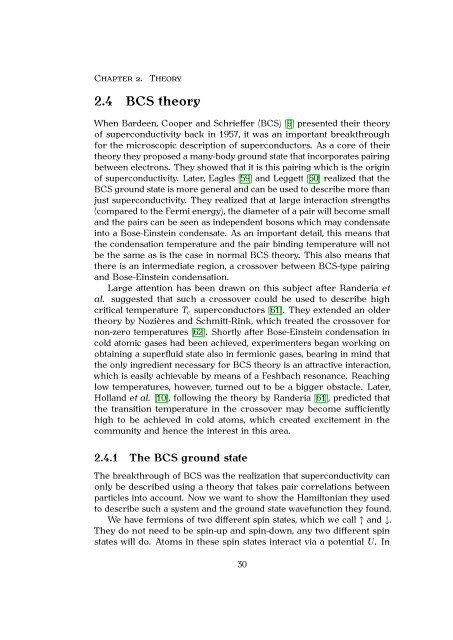Martin Teichmann Atomes de lithium-6 ultra froids dans la ... - TEL
Martin Teichmann Atomes de lithium-6 ultra froids dans la ... - TEL
Martin Teichmann Atomes de lithium-6 ultra froids dans la ... - TEL
Create successful ePaper yourself
Turn your PDF publications into a flip-book with our unique Google optimized e-Paper software.
CHAPTER 2. THEORY<br />
2.4 BCS theory<br />
When Bar<strong>de</strong>en, Cooper and Schrieffer (BCS) [9] presented their theory<br />
of superconductivity back in 1957, it was an important breakthrough<br />
for the microscopic <strong>de</strong>scription of superconductors. As a core of their<br />
theory they proposed a many-body ground state that incorporates pairing<br />
between electrons. They showed that it is this pairing which is the origin<br />
of superconductivity. Later, Eagles [59] and Leggett [60] realized that the<br />
BCS ground state is more general and can be used to <strong>de</strong>scribe more than<br />
just superconductivity. They realized that at <strong>la</strong>rge interaction strengths<br />
(compared to the Fermi energy), the diameter of a pair will become small<br />
and the pairs can be seen as in<strong>de</strong>pen<strong>de</strong>nt bosons which may con<strong>de</strong>nsate<br />
into a Bose-Einstein con<strong>de</strong>nsate. As an important <strong>de</strong>tail, this means that<br />
the con<strong>de</strong>nsation temperature and the pair binding temperature will not<br />
be the same as is the case in normal BCS theory. This also means that<br />
there is an intermediate region, a crossover between BCS-type pairing<br />
and Bose-Einstein con<strong>de</strong>nsation.<br />
Large attention has been drawn on this subject after Ran<strong>de</strong>ria et<br />
al. suggested that such a crossover could be used to <strong>de</strong>scribe high<br />
critical temperature Tc superconductors [61]. They exten<strong>de</strong>d an ol<strong>de</strong>r<br />
theory by Nozières and Schmitt-Rink, which treated the crossover for<br />
non-zero temperatures [62]. Shortly after Bose-Einstein con<strong>de</strong>nsation in<br />
cold atomic gases had been achieved, experimenters began working on<br />
obtaining a superfluid state also in fermionic gases, bearing in mind that<br />
the only ingredient necessary for BCS theory is an attractive interaction,<br />
which is easily achievable by means of a Feshbach resonance. Reaching<br />
low temperatures, however, turned out to be a bigger obstacle. Later,<br />
Hol<strong>la</strong>nd et al. [10], following the theory by Ran<strong>de</strong>ria [61], predicted that<br />
the transition temperature in the crossover may become sufficiently<br />
high to be achieved in cold atoms, which created excitement in the<br />
community and hence the interest in this area.<br />
2.4.1 The BCS ground state<br />
The breakthrough of BCS was the realization that superconductivity can<br />
only be <strong>de</strong>scribed using a theory that takes pair corre<strong>la</strong>tions between<br />
particles into account. Now we want to show the Hamiltonian they used<br />
to <strong>de</strong>scribe such a system and the ground state wavefunction they found.<br />
We have fermions of two different spin states, which we call ↑ and ↓.<br />
They do not need to be spin-up and spin-down, any two different spin<br />
states will do. Atoms in these spin states interact via a potential U. In<br />
30

















